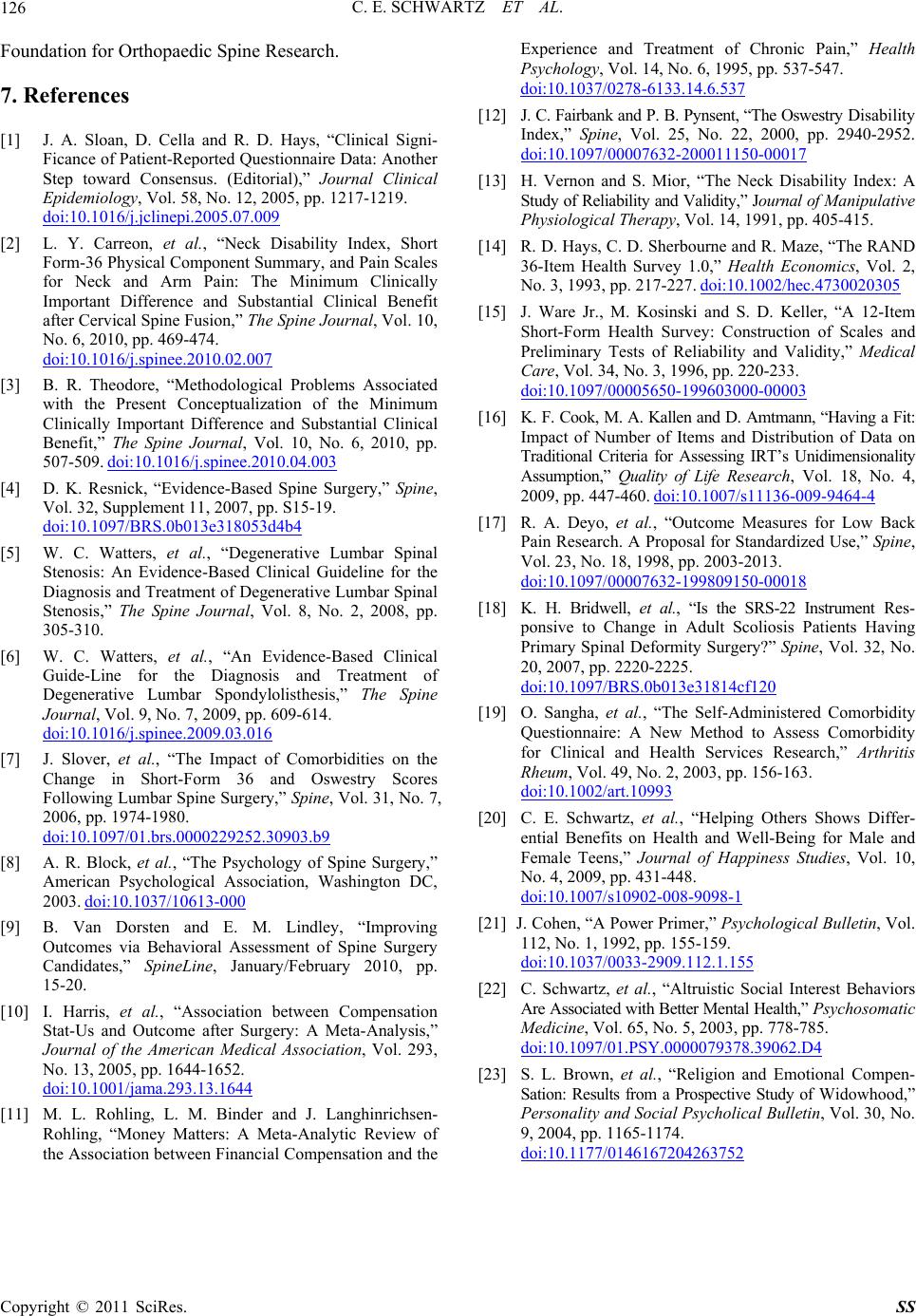
C. E. SCHWARTZ ET AL.
Copyright © 2011 SciRes. SS
126
Foundation for Orthopaedic Spine Research.
7. References
[1] J. A. Sloan, D. Cella and R. D. Hays, “Clinical Signi-
Ficance of Patient-Reported Questionnaire Data: Another
Step toward Consensus. (Editorial),” Journal Clinical
Epidemiology, Vol. 58, No. 12, 2005, pp. 1217-1219.
doi:10.1016/j.jclinepi.2005.07.009
[2] L. Y. Carreon, et al., “Neck Disability Index, Short
Form-36 Physical Component Summary, and Pain Scales
for Neck and Arm Pain: The Minimum Clinically
Important Difference and Substantial Clinical Benefit
after Cervical Spine Fusion,” The Spine Journal, Vol. 10,
No. 6, 2010, pp. 469-474.
doi:10.1016/j.spinee.2010.02.007
[3] B. R. Theodore, “Methodological Problems Associated
with the Present Conceptualization of the Minimum
Clinically Important Difference and Substantial Clinical
Benefit,” The Spine Journal, Vol. 10, No. 6, 2010, pp.
507-509. doi:10.1016/j.spinee.2010.04.003
[4] D. K. Resnick, “Evidence-Based Spine Surgery,” Spine,
Vol. 32, Supplement 11, 2007, pp. S15-19.
doi:10.1097/BRS.0b013e318053d4b4
[5] W. C. Watters, et al., “Degenerative Lumbar Spinal
Stenosis: An Evidence-Based Clinical Guideline for the
Diagnosis and Treatment of Degenerative Lumbar Spinal
Stenosis,” The Spine Journal, Vol. 8, No. 2, 2008, pp.
305-310.
[6] W. C. Watters, et al., “An Evidence-Based Clinical
Guide-Line for the Diagnosis and Treatment of
Degenerative Lumbar Spondylolisthesis,” The Spine
Journal, Vol. 9, No. 7, 2009, pp. 609-614.
doi:10.1016/j.spinee.2009.03.016
[7] J. Slover, et al., “The Impact of Comorbidities on the
Change in Short-Form 36 and Oswestry Scores
Following Lumbar Spine Surgery,” Spine, Vol. 31, No. 7,
2006, pp. 1974-1980.
doi:10.1097/01.brs.0000229252.30903.b9
[8] A. R. Block, et al., “The Psychology of Spine Surgery,”
American Psychological Association, Washington DC,
2003. doi:10.1037/10613-000
[9] B. Van Dorsten and E. M. Lindley, “Improving
Outcomes via Behavioral Assessment of Spine Surgery
Candidates,” SpineLine, January/February 2010, pp.
15-20.
[10] I. Harris, et al., “Association between Compensation
Stat-Us and Outcome after Surgery: A Meta-Analysis,”
Journal of the American Medical Association, Vol. 293,
No. 13, 2005, pp. 1644-1652.
doi:10.1001/jama.293.13.1644
[11] M. L. Rohling, L. M. Binder and J. Langhinrichsen-
Rohling, “Money Matters: A Meta-Analytic Review of
the Association between Financial Compensation and the
Experience and Treatment of Chronic Pain,” Health
Psychology, Vol. 14, No. 6, 1995, pp. 537-547.
doi:10.1037/0278-6133.14.6.537
[12] J. C. Fairbank and P. B. Pynsent, “The Oswestry Disability
Index,” Spine, Vol. 25, No. 22, 2000, pp. 2940-2952.
doi:10.1097/00007632-200011150-00017
[13] H. Vernon and S. Mior, “The Neck Disability Index: A
Study of Reliability and Validity,” Journal of Manipulative
Physiological Therapy, Vol. 14, 1991, pp. 405-415.
[14] R. D. Hays, C. D. Sherbourne and R. Maze, “The RAND
36-Item Health Survey 1.0,” Health Economics, Vol. 2,
No. 3, 1993, pp. 217-227. doi:10.1002/hec.4730020305
[15] J. Ware Jr., M. Kosinski and S. D. Keller, “A 12-Item
Short-Form Health Survey: Construction of Scales and
Preliminary Tests of Reliability and Validity,” Medical
Care, Vol. 34, No. 3, 1996, pp. 220-233.
doi:10.1097/00005650-199603000-00003
[16] K. F. Cook, M. A. Kallen and D. Amtmann, “Having a Fit:
Impact of Number of Items and Distribution of Data on
Traditional Criteria for Assessing IRT’s Unidimensionality
Assumption,” Quality of Life Research, Vol. 18, No. 4,
2009, pp. 447-460. doi:10.1007/s11136-009-9464-4
[17] R. A. Deyo, et al., “Outcome Measures for Low Back
Pain Research. A Proposal for Standardized Use,” Spine,
Vol. 23, No. 18, 1998, pp. 2003-2013.
doi:10.1097/00007632-199809150-00018
[18] K. H. Bridwell, et al., “Is the SRS-22 Instrument Res-
ponsive to Change in Adult Scoliosis Patients Having
Primary Spinal Deformity Surgery?” Spine, Vol. 32, No.
20, 2007, pp. 2220-2225.
doi:10.1097/BRS.0b013e31814cf120
[19] O. Sangha, et al., “The Self-Administered Comorbidity
Questionnaire: A New Method to Assess Comorbidity
for Clinical and Health Services Research,” Arthritis
Rheum, Vol. 49, No. 2, 2003, pp. 156-163.
doi:10.1002/art.10993
[20] C. E. Schwartz, et al., “Helping Others Shows Differ-
ential Benefits on Health and Well-Being for Male and
Female Teens,” Journal of Happiness Studies, Vol. 10,
No. 4, 2009, pp. 431-448.
doi:10.1007/s10902-008-9098-1
[21] J. Cohen, “A Power Primer,” Psychological Bulletin, Vol.
112, No. 1, 1992, pp. 155-159.
doi:10.1037/0033-2909.112.1.155
[22] C. Schwartz, et al., “Altruistic Social Interest Behaviors
Are Associated with Better Mental Health,” Psychosomatic
Medicine, Vol. 65, No. 5, 2003, pp. 778-785.
doi:10.1097/01.PSY.0000079378.39062.D4
[23] S. L. Brown, et al., “Religion and Emotional Compen-
Sation: Results from a Prospective Study of Widowhood,”
Personality and Social Psycholical Bulletin, Vol. 30, No.
9, 2004, pp. 1165-1174.
doi:10.1177/0146167204263752